Don't Have a Cow, Man! It's Just a Bart Torvik Query
Corey Tulaba's Overcaffeinated Deep Dive Into Statistical Outliers, Draft Sleepers, Future Dudes, and the Art of Using Barttorvik Without Cooking the Books.
If you've spent any amount of time scrolling through Draft Twitter—or as I like to call it, the world’s worst social media platform that I can’t seem to quit—you’ve probably seen those cryptic stat graphics that look like they were designed by a mad scientist with a spreadsheet fetish. You know the ones: the graphics that look like a jumble of numbers and obscure metrics that somehow prove that Player X is the next Paul George, or that Player Y is on the fast track to become Derrick Williams 2.0.
They look something like this:
Inevitably, someone in the Twitter replies will ask, “What site is this from?”
For the uninitiated, the answer is Barttorvik.com—a digital wonderland for basketball sickos, draft nerds, and anyone who gets legitimately turned on by terms like "variance." It’s this utopian kingdom of advanced metrics, team stats, and player profiles that lets you go deeper into the numbers than a Reddit user spiraling into conspiracy theories about the moon landing. The best part? You can lose a solid three hours on there, only to emerge and tweet something like, “Did you know this mid-major prospect has a higher PER than Zion did as a freshman?”
Let’s be clear—Barttorvik is a national treasure. If I ever met Bart, I’d probably salute him like a data-drunk soldier and say, “thank you for your service” (strictly in a respectful, non-weird way). Barttorvik has pushed draft analysis forward like a jolt of caffeine to the brain. But here's the catch: like any sharp tool, it can be used for both good and evil. I’ve had moments when I see a query that makes me feel like the devil and god are raging inside me. Not because I’m some self-appointed arbiter of draft holiness—trust me, I’m not—but because, like any tool, the site can be twisted to support any narrative you want to tell about a prospect.
And, hey, I get it. We all do it. It’s kind of fun to cherry-pick stats and pretend like you’ve unlocked some hidden truth about a prospect. “This guy’s the next Kawhi Leonard!” Or, more satisfyingly, “This dude is doomed to be the next James Bouknight!” By the time you’re done reading this, you might even accuse me of doing the exact same thing with the queries I’ve pulled together. But before we dive into the madness, let me explain how I crafted this little statistical experiment.
How I Built the Queries: A Guide to Statistical Sorcery
First, I built a list of current NBA players, spanning the spectrum from superstars to role players. I then painstakingly entered their pre-draft college stats into a Google Sheet—because nothing makes my wife feel more like she made a brilliant life choice than watching me manually enter data from some obscure NCAA season that took place six years ago.
Next, I calculated the averages for specific categories that I believe are key indicators of NBA success based on positional designations. For example, if I’m looking for the next great 3-and-D wing, I may focus on stats like steal rate, block rate, three-point percentage, 3PT/100, etc. Then, to dig a bit deeper, I calculated the standard deviation for each category to measure how much variability exists within the dataset.
Finally, I turned to Barttorvik and plugged in these numbers using thresholds that were either one standard deviation or a half standard deviation below the mean. Why? Because I wanted to set a low-end baseline to find prospects who hit statistical markers that have historically predicted NBA success but might be flying under the radar. It’s like a treasure hunt, but instead of gold, I’m digging for the next Sam Merrill or Tyrese Maxey!
Why Any of This Matters
The beauty of Barttorvik is that it lets you ask questions like, “Which prospects have a steal rate above 2.5%, a block rate above 3%, and shot over 38% from three since 2008?” And when you find those players, you may start to see patterns emerge. Maybe they’re not the flashiest names on draft boards, but their numbers might suggest that they could be hidden gems. Or maybe you turn on the tape and realize they’re probably just statistical anomalies who peaked in college. Either way, it’s a fascinating exercise that blends art and science—or, as I like to call it, basketball alchemy.
So, buckle up. We’re about to dive into the queries, the numbers, and the prospects who might just be the next big thing. And if you think I’m manipulating the data to fit my narrative…well, you’re probably right. But hey, that’s half the fun.
Hot Wings Query: Identifying Impact Wings
Every NBA team is on an eternal pilgrimage to find the Holy Grail: a wing who won’t completely disintegrate the second the playoffs get real. We’re talking about dudes who can shoot without triggering flashbacks to Ben Simmons in the fourth quarter, defend without turning into barbecue chicken, and swing the ball without sending their coach into a stress-induced existential spiral.
The modern NBA wing is a shapeshifter—a blend of efficiency, physicality, feel, and enough statistical juice to matter without needing the ball every possession. It’s a delicate balance. Thanks to Barttorvik, the official church of the Data Draft Sickos, we’ve got the tools to start narrowing the search.
Here’s the statistical DNA we were looking for:
Height ≥ 78"
BPM ≥ 7.3
TS% ≥ 56
Def Reb % ≥ 12.8
Assist % ≥ 12
Ast/TO Ratio ≥ 1
Block % ≥ 1.8, Steal % ≥ 1.9
3PA/100 Poss ≥ 5.8
FG% at Rim ≥ 58.75
Dunks ≥ 20
On my first attempt to find our wing group, I used inputs one standard deviation below the mean. This gave me a list of results with some interesting names, most of whom will likely get a cup of coffee in the league. However, when I used Bart's "all years" function, I got a list that was too broad, with a long mix of both NBA hits and misses. There was no clear pattern in the results to suggest the query could reliably predict who might actually stick in the NBA—a little frustrating, but that’s the reality of sifting through data. After narrowing the thresholds from 1.0 to 0.5 standard deviations below recent historical NBA averages, two 2025 prospects emerged: Cooper Flagg and Nique Clifford.
And here's why that's spicy: every single player who’s hit this query has become at least a rosterable multi-year NBA dude. Not All-Stars, necessarily—but real-deal NBA guys. No flukes. No filler.
Let’s talk about the dudes.
Cooper Flagg, Duke, 6’8” Swing Wing
It should be no surprise that Flagg ended up on this list as he’s been one of the most hyped American-born prospects we’ve had in, um, let’s say a while. Somehow, he didn’t just live up to the hype, but he overdelivered on it, clocking in one of the strongest freshman campaigns in recent memory. And oh yeah, he should still be a senior in high school.
On the court, Flagg does literally everything you want a wing to do. While his off-the-dribble perimeter game looked questionable early on, Flagg quickly vaporized those concerns, continuing to hone in on those skills and comfortably scoring at all three levels by the end of his freshman campaign. Flagg creates and maintains advantages, makes plays for his teammates at a high level, is a Swiss-army knife defender, and is as competitive as you can ever ask a player to be. The scary part of it all is that he’s just scratching the surface of the kind of player he wants to become.
Nothing is guaranteed in life. However, Flagg isn’t just on the path to stardom; he looks the part of a future superstar.
Nique Clifford, Colorado State, 6’6” Wing
Nique has been a hot name this cycle, steadily climbing and cementing himself as a Top 20 prospect in the class, but I’ve been beating the draft Nique Clifford drum since early last cycle (sorry for being obnoxious about it).
The reason for his ascension this cycle? He became the human embodiment of "winning basketball." His statistical profile glows like a neon sign, and the film shines just as bright.
There were few players more important to their team than Nique, as Clifford finished second in Evan Miya’s Most Indispensable Players metric this year (sandwiched between Braden Smith and—you guessed it—Cooper Flagg), and it checks out as he did a bit of everything for Colorado State: initiator reps, shot making, versatile defense, off-ball activity, and lots of winning. In an era where wings need to toggle between positions like a Swiss Army knife, Clifford fits the mold.
No, he doesn’t have Jalen Williams’s wingspan or jaw-dropping combine measurements, but what he does have is a blend of strength, touch, and feel that shows up in every box score—and every advanced stat sheet. He measured 6’5” barefoot with a 6’8” wingspan at last year’s combine and promptly returned to college to get even better. Smart move. He took another leap and somehow popped on this query again, which speaks volumes to his consistency and growth curve.
Could he be this draft’s Jalen Williams? Not impossible. Could he be this class’s Christian Braun? More likely. Either way, he’s got “NBA player” written all over him, and in today’s league, that’s not a consolation prize—it’s job security.
Guard Query: Finding Floor Generals Who Don’t Fall Apart
Alright, let’s go hunting for guards, shall we? Not just high-usage chuckers who get away with it because nobody else on the roster can dribble, but dudes who can actually play. The guys who can orchestrate, pressure the rim, shoot it enough to keep the defense honest, and hold up (at least somewhat) on the other end.
Here’s the statistical wishlist I used to try and sniff them out:
BPM ≥ 6.8
OBPM ≥ 4.2
TS% ≥ 57.3
3PA/100 Poss ≥ 7.8
FTr ≥ 28.7
DReb% ≥ 10.4
AST% ≥ 17.7
Ast/TO Ratio ≥ 1.6
STL% ≥ 1.7
BLK% ≥ 0.9
FG% at rim ≥ 58.4
Dunks ≥ 1.9
Far 2s attempted ≥ 61.5
Far 2 FG% ≥ 37
USG ≥ 22.2
Sounds like a lot? That’s because it is. The modern guard has to do stuff at an extremely high level, and if you’re under 6’3” and not named Fred VanVleet or Payton Pritchard, good luck finding a home if you can’t.
The problem? In college, smaller guards run the show because most wings just aren’t polished enough to handle the load. So you get these guys with bloated usage and inflated stats that don’t always scale. Size matters more in the league, which means that this query, while statistically sound, came with some contextual landmines.
Still, it spat out some solid names: guys with real production, real feel, and at least a fighting chance of scaling their game up. And just when I thought we were done with Nique Clifford…guess who popped up again?
Yup. He’s back like He Who Shall Not Be Named.
I won’t rehash the full Clifford breakdown here (scroll up for the sermon), but it’s worth noting that showing up in both a wing and guard query is a giant neon sign blinking malleability. And it’s part of why teams should be excited about the idea of Nique at the 2, 3, or even 4, depending on the scheme and staff. If Tom Thibodeau had him, he’d probably play him at center just to prove a point.
All-NBA Guard Query: Searching for Star-Level Statistical DNA
Okay, now let’s crank the difficulty setting to expert and try something a little different—what if we built a query based on All-NBA guards?
What kind of statistical profile do those guys have in college?
To find out, I cooked up this recipe using the average numbers from All-NBA guards over the last 15-ish years and adjusted the thresholds to be one standard deviation below those marks. The idea: could we find guys who maybe aren’t supernova prospects yet, but share the statistical blueprint of someone who might become one?
Here’s what I rolled with:
BPM ≥ 8.2
OBPM ≥ 5.4
TS% ≥ 55.4
3PA/100 Poss ≥ 5.2
FTr ≥ 29.4
OReb% ≥ 2.46
DReb% ≥ 9.4
AST% ≥ 17.5
Ast/TO Ratio ≥ 1.2
STL% ≥ 1.7
BLK% ≥ 0.9
FG% at rim ≥ 58.8
Dunks ≥ 2.4
Far 2s attempted ≥ 57.9
Far 2 FG% ≥ 33.9
USG ≥ 22.6
Conf = High Major
Now, let’s be honest—nobody from the actual All-NBA sample hit every one of these marks pre-draft either. Even stars have weak spots. So I wasn’t expecting a list of future Hall-of-Famers to pop out.
What I did get, though, were two current 2025 prospects who might offer the highest ceilings in the class: VJ Edgecombe and Cooper Flagg.
If you’re keeping score at home, that’s two separate queries Flagg has broken, and he’s not even a guard, which, like Nique, should tell you all you need to know about how adaptable and devastating Coop’s statistical profile is. He’s a positionless basketball savant who’ll play wherever the team needs him—and dominate while doing it. Primary playmaker? Sure. Bucket getter? No Problem. Eye test and Stat Nerd FC unite.
Now let’s talk about the actual guard.
VJ Edgecombe, Baylor, 6’5” Guard
VJ’s presence here shouldn’t surprise anyone. He came into the season projected as a Top 5 pick and may have played his way into the Top 3. On paper, he looks like a modern NBA guard born in a lab: electric burst, elite vertical pop, livewire motor, and a legit physical presence on both ends. He’s chaos in motion. In a good way.
He’s listed at 6’5” but probably measures closer to 6’3”, which would usually be a red flag. Then you watch him detonate at the rim or swallow a passing lane whole, though, and the measurements stop mattering.
Where VJ has an Edge (hehe) on both of those dudes is that as a freshman, he is already a capable outside shooter. No, the off-the-dribble jumper isn’t there yet. But the spot-up mechanics are clean up top (let’s widen that base, though), the numbers are sturdy (45.7% on unguarded catch-and-shoots), and his pre-college track record suggests it’s real. The combination of rim pressure and budding shooting gravity? That’s a scary mix, and a pretty good indicator of NBA success.
As you can see from the Bart Chart above, Edgecombe was one of just two players in the 2025 class to achieve 30 dunks and 50 threes during his freshman season. The other prospect? You guessed it, Cooper Flagg. A query within a query. Y'all just got inceptioned.
On the defensive end, Edgecombe is a real-deal event creator. He posted an enticing 3.8 STL% and 2.3 BLK%—numbers you’d expect from a hyperactive wing, not a freshman guard. He gets into people’s shirts, rotates with force, and has the kind of instincts that let you live with a few gambles because he’s going to swing momentum with his activity.
He’s not a finished product. The handle still needs refinement. The in-between game is a work in progress. But the bones of a high-end two-way guard are already in place.
If you want a comparison path? Think Victor Oladipo’s developmental arc—someone who entered the league a little raw offensively, was given the keys in Orlando to experiment (and struggle), but grew into an All-Star once the pieces fell into place. That should be the blueprint here. Give VJ reps. Give him patience. Give him a runway. And in a few years, he might give you back a star.
Shooter Wings Query: Identifying Elite Floor-Spacers
Before we start thinking bigger, let’s give our specialists some love. In today’s NBA, shooting is less of a skill and more of a prerequisite. If you can't space the floor, knock down open shots, and occasionally make the defense question their life choices, you're probably not long for the NBA. With that in mind, there are shooters, and then there are SHOOTERS. So, let’s take a stab at identifying 2025’s most promising shooting wings.
The statistical inputs for this query are as follows:
Height ≥ 76”
OBPM ≥ 4.5
TS% ≥ 57
3P FG% ≥ 38.5
3PA/100 Poss ≥ 10.5
Free Throw % ≥ 84
FG% at rim ≥ 0.55
Far 2s attempted ≥ 43
Far 2 FG% ≥ 36
Ast/TO Ratio ≥ 1.5
Before we get to the fresh faces, let’s take a quick look at the historical company this query keeps. Past hits include names like Sam Merrill, Sam Hauser (twice!), Denzel Valentine, and R.J. Hunter—all of whom have logged real NBA minutes. The lone outlier? Kris Jenkins, who had his post-Villanova trajectory cut short by a hip injury before he could get his shot.
In other words: if you show up on this list, odds are you’re at least getting a cup of coffee in the league.
Now, onto the 2025 class. Four names made the cut: Kon Knueppel, John Poulakidas, Koby Brea, and Jacksen Moni.
Let’s break ‘em down.
Kon Knueppel, Duke, 6’7” Shooting Guard
Kon Knueppel is the only freshman to make our list, and while his numbers scream “specialist,” watching him play quickly reveals that pigeonholing him as just a shooter doesn’t do the kid justice. Yes, he checks every statistical box on this shooting-wing query—40.6% from deep on high volume, 91.4% from the line, and a buttery 64.2 TS%—but Kon’s offensive game is far more layered than the query lets on.
Despite being the youngest name on this list, Knueppel was a certified bucket in the ACC. His shot mechanics are pristine and repeatable, and he shows the kind of versatility you want from a modern NBA shooting guard: catch-and-shoot? Easy. Relocation threes? Routine. Off-the-dribble midrange pull-ups against drop coverage? Money. That last bit was particularly lethal when paired with Duke’s lob threat Khaman Maluach, as Kon’s pull-up gravity in the in-between routinely pulled the big up, creating easy alley-oops which Kon dropped in with feathery touch.
Kon also flashed the ability to read closeouts and attack them decisively, finishing well at the rim thanks to strong footwork, timing, and touch—even if he’s not exactly punching on dudes. He’s not a high-flyer, and the burst isn’t elite, but he knows who he is, and more importantly, who he isn’t.
Defensively, the athletic limitations could show up more starkly at the next level. He’s smart and competitive on that end, but quicker NBA wings will test his foot speed. That said, the same things were said about Desmond Bane coming out, and while Bane had more bulk, Kon’s younger and just as skilled.
In a class that lacks surefire stars, Knueppel stands out as one of the most complete offensive guards. The fact that he also grades out as one of the best shooters in the country is just icing. The real question isn’t whether he can stick in the NBA—it’s how high he goes in June.
John Poulakidas, Yale, 6’5” Shooting Guard
If you're looking for an under-the-radar sniper who does more than just stand in the corner and wait for scraps, allow me to introduce you to John Poulakidas, a 6’5” lefty who has knocked down 40% of his 500+ career triples while spending the last four years terrorizing nets in the Ivy League like a tenured professor of splashology. Poulakidas hit 41% of his threes this year, canned 48% of his 150 far twos (a spicy diet, by the way), and knocked down 89% of his freebies at the charity stripe.
What separates Poulakidas from your garden-variety catch-and-shoot guy is his versatility. He’s got deep range, can shoot on the move, and has real craft to get into pull-ups and step-backs off the bounce. He’s not some stationary turret; he’s the whole artillery. Throw in a 1.5 AST/TO ratio and fewer than one turnover per game across his career, and you’ve got a guy who values possessions like gold.
Now, the elephant in the room: he’s not blowing by defenders, and the vertical pop is closer to “respectable intramural” than “combine highlight.” He’s a smart defender but probably won’t be racking up stocks anytime soon. That said, he knows where to be and plays hard, which helps. His game might not ooze upside, but shooters of this caliber with real shot versatility tend to find a way. Don’t be surprised when a smart front office nabs him and lets him bake.
Koby Brea, Kentucky, 6’7” Wing
Koby Brea is a walking "stay attached" scouting report note. After four years lighting it up at Dayton, he took his talents to Lexington for one more go-round—and, surprise! He kept hitting everything. Brea has hit 43% of nearly 700 career threes, a ridiculous number that somehow undersells just how automatic he looks when he gets his feet set.
At 6’7” with a high, picturesque release, Brea is a problem. He can shoot off movement, knock down one or two-dribble pull-ups, and relocate like a seasoned vet. Offense slows down when he’s on the court—in a good way—and his 3:1 AST/TO ratio suggests he’s not just a finisher, but a connective piece who keeps things humming. He’s not threading skip passes like he’s Luka, but he sees the floor and keeps it simple.
Where Brea struggles is where a lot of elite shooters do: rim pressure and defense. He’s not blowing past defenders or creating defensive events on the other end. The tools just aren’t quite there in terms of twitch and pop (though he’s been recovering from an injury). But given his size, shooting consistency, and feel, he looks tailor-made to be a 7th or 8th man in the NBA who hits open shots and doesn’t beat himself. There's value in knowing exactly what you are—and Brea does.
Jacksen Moni, North Dakota State, 6’10” Forward
Jacksen Moni is perhaps the most intriguing name on this list, for a number of reasons, starting with the fact that he’s gigantic at a listed 6’10”. The size opens your eyes, but the buttery jumper and playmaking juice in concert with the size? Yeah, that’ll get you flagged by an analytics model or two.
Moni started his career at the D-II level, which may temper enthusiasm, but don’t let that fool you—he can hoop. He knocked down 40% from deep on strong volume, and his release is the kind of repeatable, clean motion that scales. But where things get interesting is his secondary playmaking. Moni’s got real touch as a passer, especially in ball screens where he operates as the initiator and the screener. He’ll hit the roller, manipulate defenders with his eyes, and punish lazy rotations. Not a point forward, but he reads the game.
Of course, there’s a reason he’s not on everyone’s boards. The athleticism is a question mark—he’s not bursting past guys, and the defense can be shaky in space. Against better athletes, that lack of quickness and physicality could be a problem. But when you’re 6’10” and can shoot, pass, and think, teams tend to give you a real shot. He’s the kind of guy you bet on late in the draft and hope the processing and skill win out. If nothing else, he’s big and can shoot shoot. And that’s enough to keep him in the conversation.
Big Dawg Query: Identifying Impact Centers
Alright, enough with the pretty boys on the perimeter. Let’s talk about the Big Dawgs.
And unfortunately, not the stretchy, hypothetical, 7-foot flamethrowers who exist more in our dreams than they do in real life. I’m talking about the kind of bigs that make you say, “OK, he’s not changing your franchise, but I trust him to win a shift when it matters.” The grinders. The screen-setters. The guys who don’t need the ball to matter.
Finding value bigs in the modern NBA is basically the basketball version of Sudoku—you think you’ve got it figured out until a late-second-round pick becomes Isaiah Hartenstein. Teams want unicorns, sure, but they’ll happily settle for a dude who rebounds, protects the rim, finishes plays, and doesn’t trip over his own feet when asked to defend in space. Bonus points if he can throw a pass and run a dribble-handoff without turning into a pumpkin.
So, how do we separate the dependable from the dinosaurs? That’s where the “Big Dawg Query“ comes in. The inputs are a cocktail of stats measuring rebounding, rim protection, finishing, physicality, and enough efficiency so as to not torpedo an offense.
And in the 2025 season, only one name survived the cut: UConn’s Tarris Reed.
BPM ≥ 8.2
TS% ≥ 61.25
Def Reb % ≥ 20.7
Off Reb % ≥ 10.5
Ast/TO Ratio ≥ 0.55
Block % ≥ 7.8
FTr ≥ 42.5
Technically, if you loosen the belt and go a full standard deviation below the mean instead of just a half-deviation, Duke’s Khaman Maluach sneaks in too—but that version of the query spit out too much noise across past classes that I couldn’t trust the results. For the record: I love Maluach. He’s a Top 5 guy in this class for me. However, he doesn’t quite fit the mold here. Close only counts in horseshoes and hand grenades, ya know?
But before we break down Reed’s game, let’s take a step back and look at the history presented by this query. This query brings up a mix of NBA contributors (Cole Aldrich, who had a nice run as a reliable backup) and some genuine stars (a level of projection I wouldn’t dare put on him). The one miss? A 6’6” mid-major center.
So what gives with Reed? Why wasn’t he on more boards?
Simple answer: he doesn’t shoot. Like, at all. His career three-point total (three shots!) is so low it might qualify as parody. His free-throw percentage is also in “let’s not mention that again” territory. But here’s the thing—most good NBA bigs didn’t shoot in college either. In fact, the average pre-draft NBA center who carved out a meaningful role shot just 1.8 threes per 100 possessions. Big shooting is cool, but it’s not required for guys like Reed. What is required? Rebounding. Screening. Rolling. Defending. Winning.
And that’s where Reed shines. His junior-year leap at UConn wasn’t just a glow-up—it was a full-blown metamorphosis. His BPM jumped from 0.4 to 9.6. His block rate ballooned to 9.0%. His TS% climbed 13 percentage points like it had a rocket strapped to it. Reed stopped being just a “big body” and started becoming a real dude.
On offense, he’s a violent screen-setter and legit lob threat. He’s never going to orchestrate an offense, but he’s shown enough feel in handoffs and short-roll reads to not be a ball stopper. He’s physical without being reckless, and he’s learning how to use that strength to carve out space instead of just brute-forcing it.
Defensively? He’s a tree stump with feet. The kind of guy who sets up shop in the post and doesn’t move unless you bring a forklift. Reed bodied up Ryan Kalkbrenner this year and made him work for every inch. UConn even had him switching out on perimeter guys like Kam Jones, and Reed held his own. He’s not some switch-everything big, but he’s nimble enough to survive in a scheme and strong enough to keep fives off the glass.
The Verdict: Tarris Reed isn’t flashy. He’s not going to headline any mock drafts. But he’s 6’10”, 250 pounds, and does a lot of the little things. He rebounds, he defends, he scores efficiently, and he knows who he is. He’s not Embiid. He might not even be Aldrich. But he looks like a future NBA backup big who sticks around for a while. And heading into his senior year at UConn, he’s someone you need to be tracking for 2026.
Final Thoughts: The Stats Don’t Lie…But They Don’t Tell the Whole Truth Either
If you’ve made it this far, first of all: I salute you. You’ve just sifted through thousands of words and a heap of advanced metrics, all in search of one thing—clarity in chaos. Then again, maybe you just wanted to see if your favorite sleeper made the cut. Either way, welcome to the part where we step back, exhale, and remind ourselves what all this statistical gobbledygook actually means.
Look, I’m not here to sell you a magic formula. These queries aren’t prophecy—they’re conversation starters. Tools. A flashlight in the draft night darkness. They can help highlight undervalued role players, project upside, or spark deeper film study, but they’re not gospel. Every year, players fall through the cracks. Every year, others hit all the right benchmarks and still don’t pan out. Sometimes the stats lie. Sometimes your eyes do.
But when you marry both—when you use the numbers to ask better questions, not just justify your hunches—you start to uncover real value.
What we found in this year’s Barttorvik-fueled expedition was a cluster of players who consistently hit data points that correlate with NBA success. Guys like Kon Knueppel, who shoots like he was born inside a shooting machine but has the ancillary skills and polish to be more than a specialist. Or Tarris Reed, a throwback big who showed modern polish this year and looks ready to bully his way onto a rotation one day. Or Nique Clifford, who popped across multiple queries like a statistical whack-a-mole and might be one of the most versatile plug-and-play wings in the class. That’s not to mention VJ Edgecombe, who might not just be one of the most statistically tantalizing guards in the class, but one of the most aesthetically thrilling ones too—equal parts firework and freight train.
And that’s the beauty of the modern NBA draft. It’s not always about finding stars. It’s about finding skillsets. It’s about finding fits. It’s about finding guys who can survive on the court with real NBA talent around them, guys who don’t just exist in the league—but thrive in their role.
So yeah, maybe you think I’ve cherry-picked my way into a conclusion. Maybe you think I’ve leaned a little too hard on Barttorvik and not enough on the film. Maybe you’re right. But if nothing else, I hope this helped you see the value of using every tool available—numbers, film, context, intuition—to paint the fullest picture possible.
Because the truth is, the NBA Draft isn’t solved in spreadsheets or mixtapes. It’s solved somewhere in between.
And the real sickos? Well, we live in that in-between.



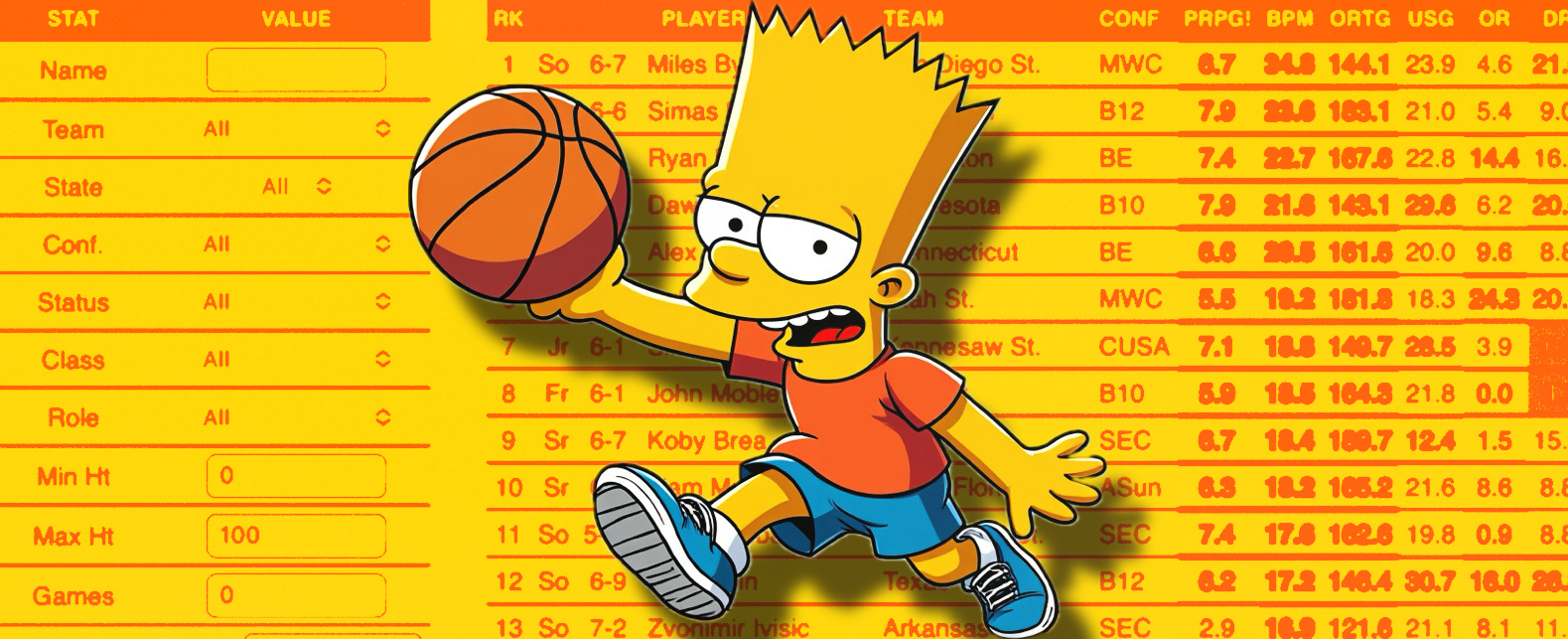
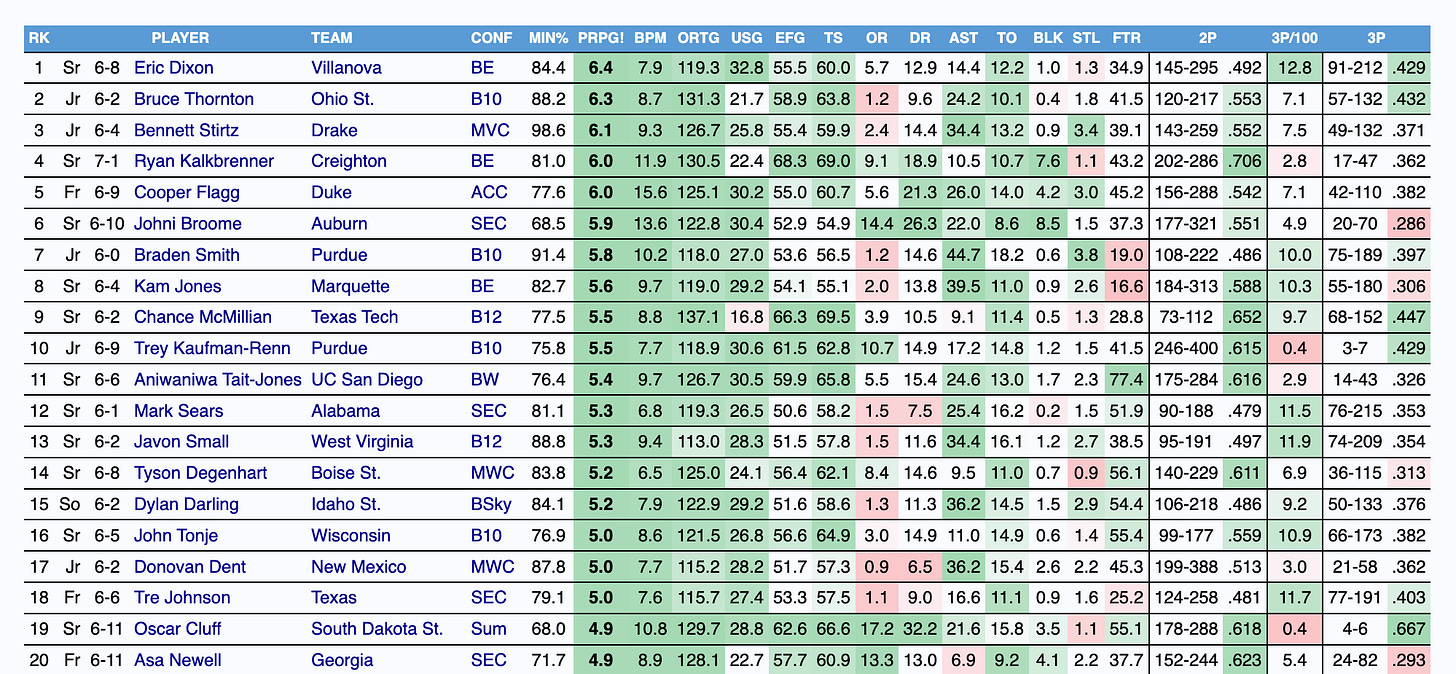
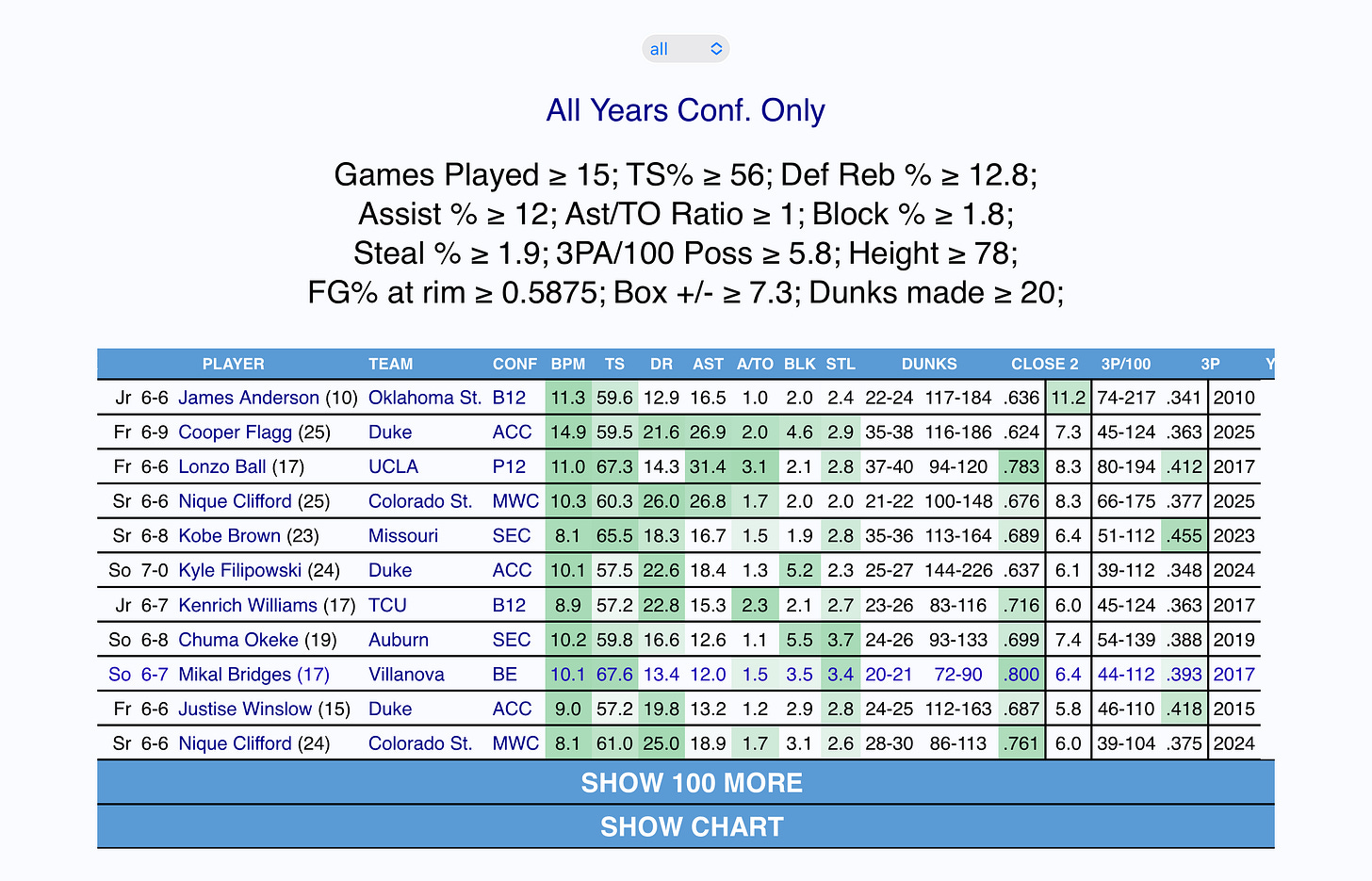
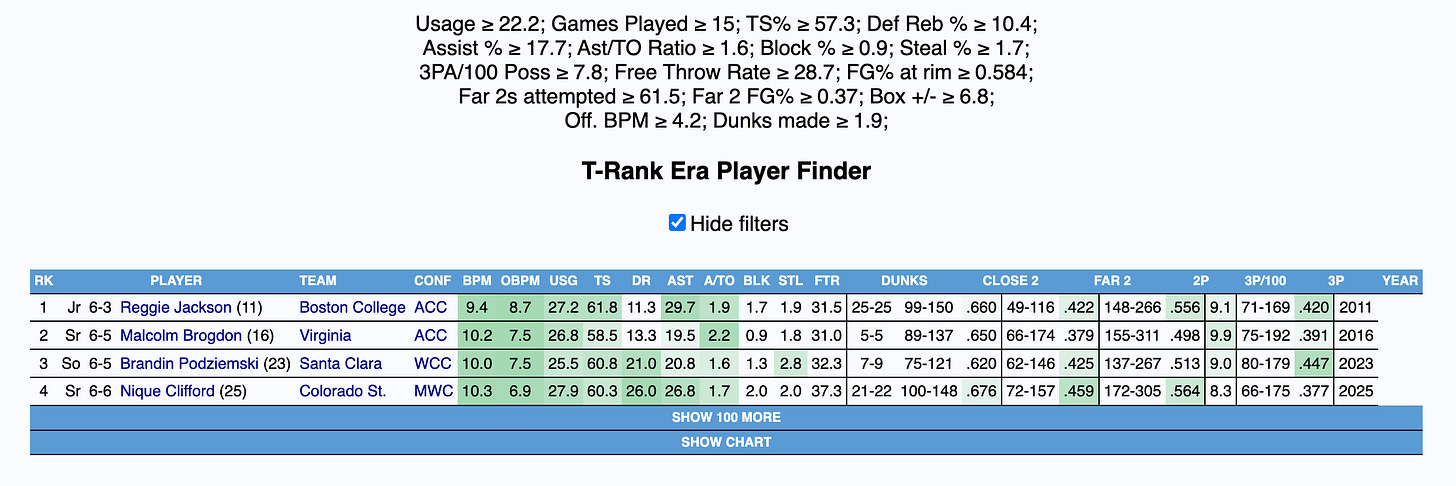
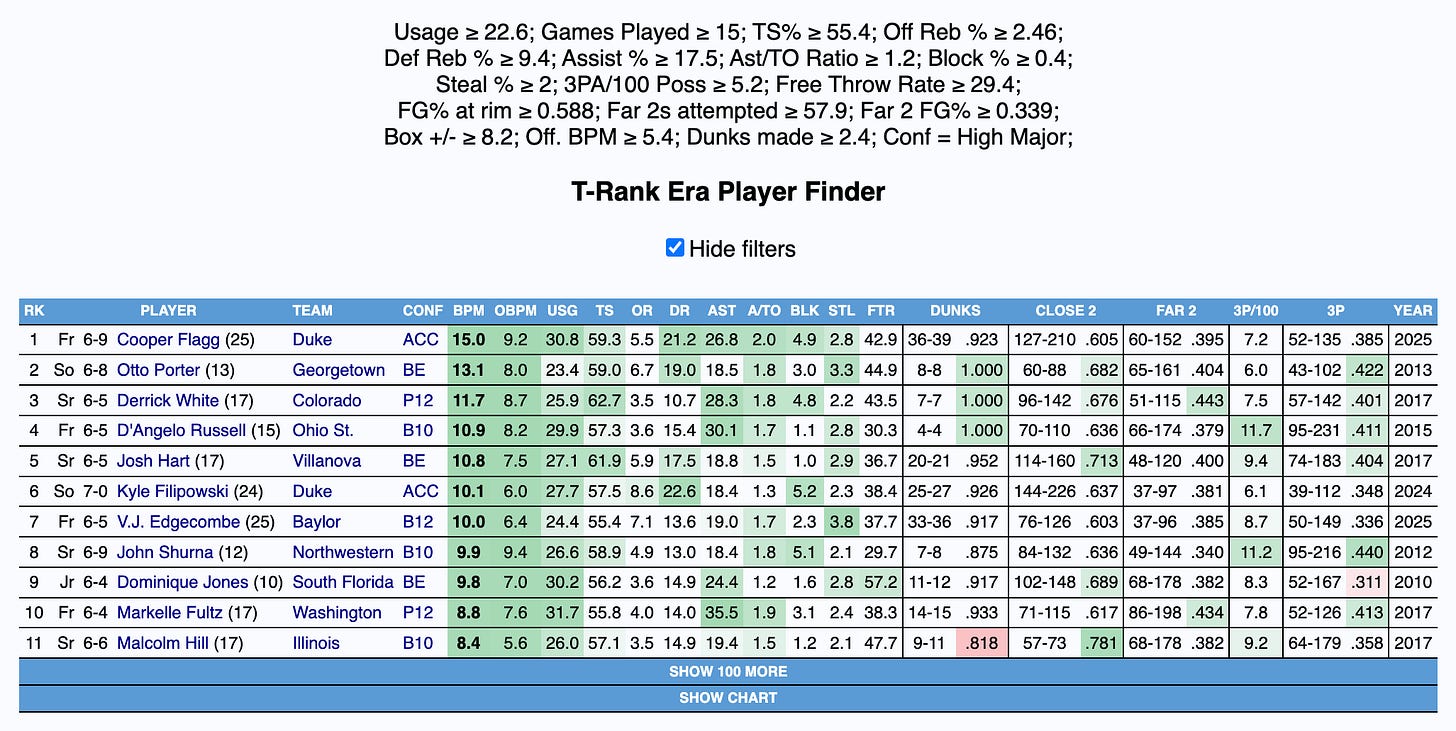
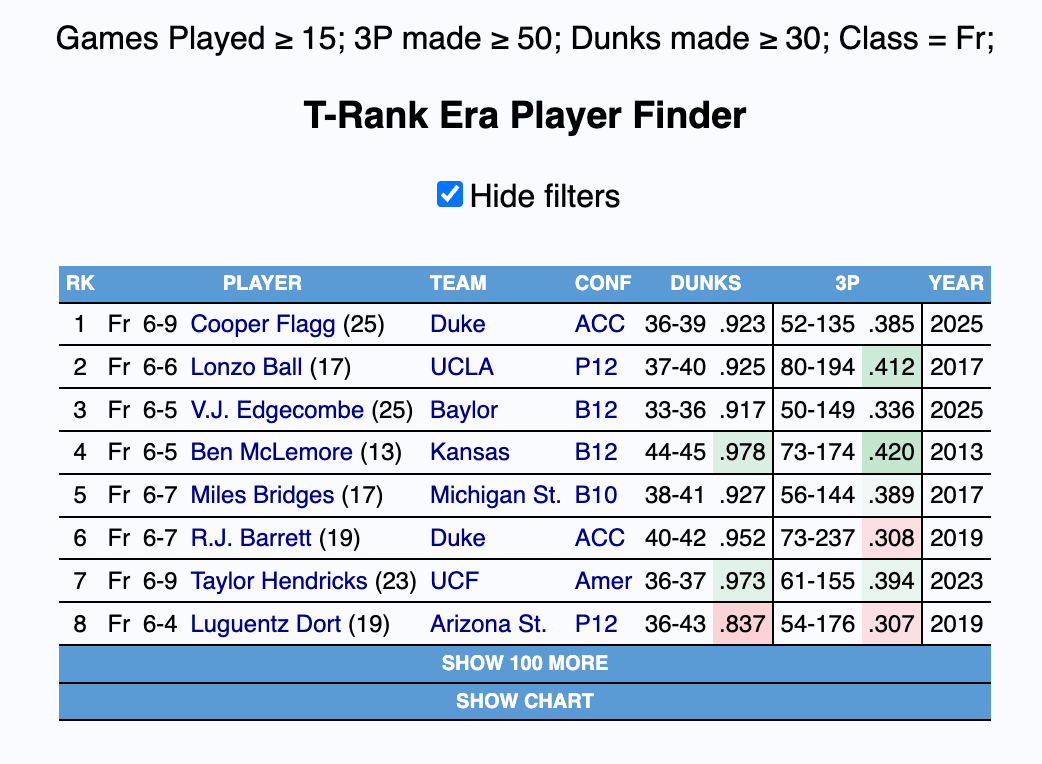
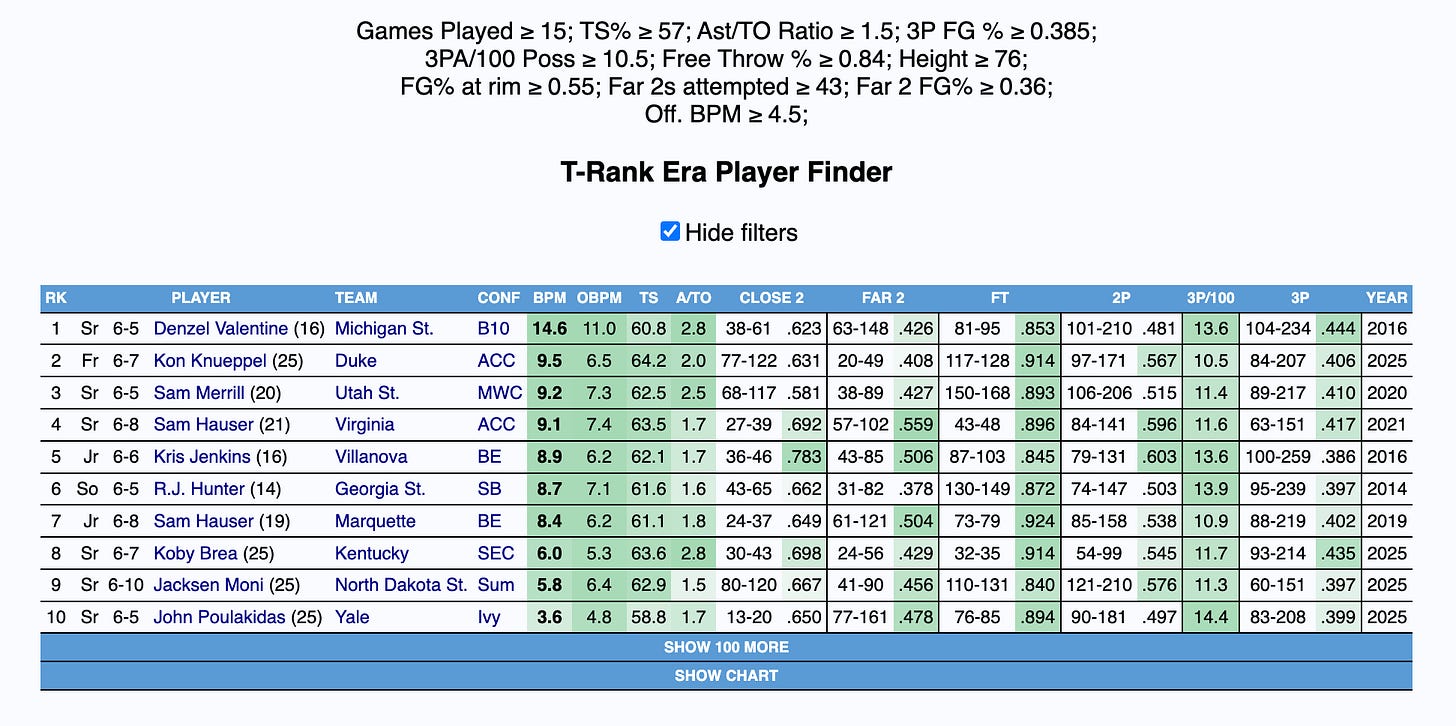
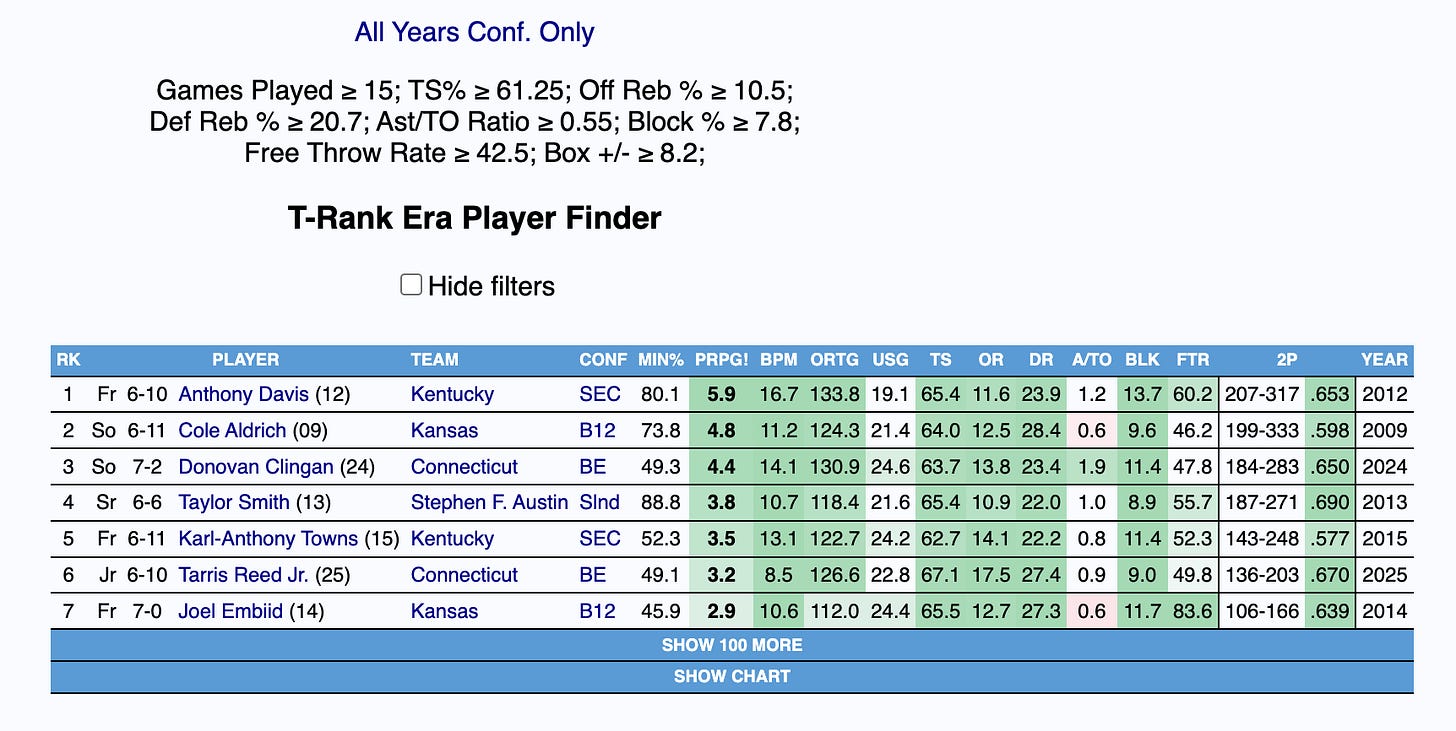
as a Bart torvik addict I love this
This was so good...give me another good sir